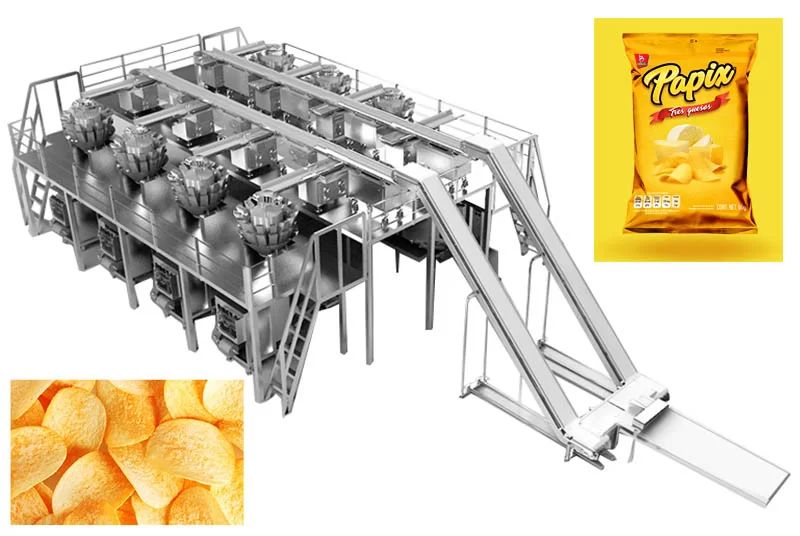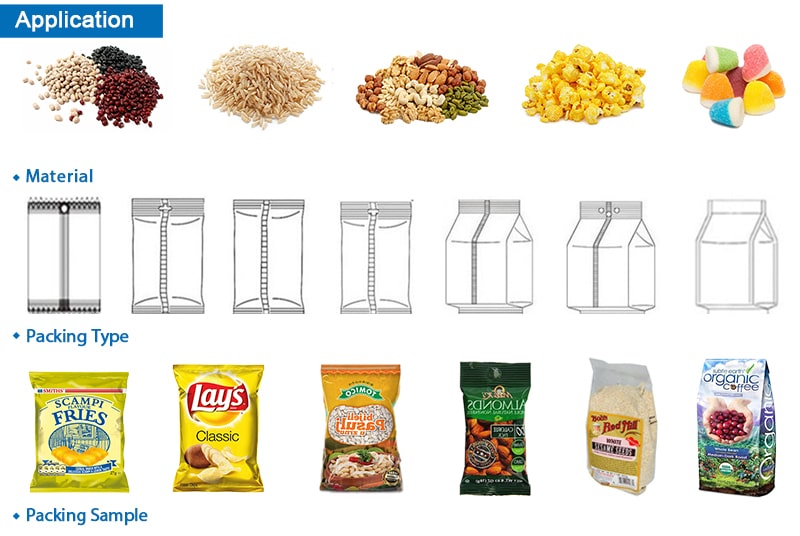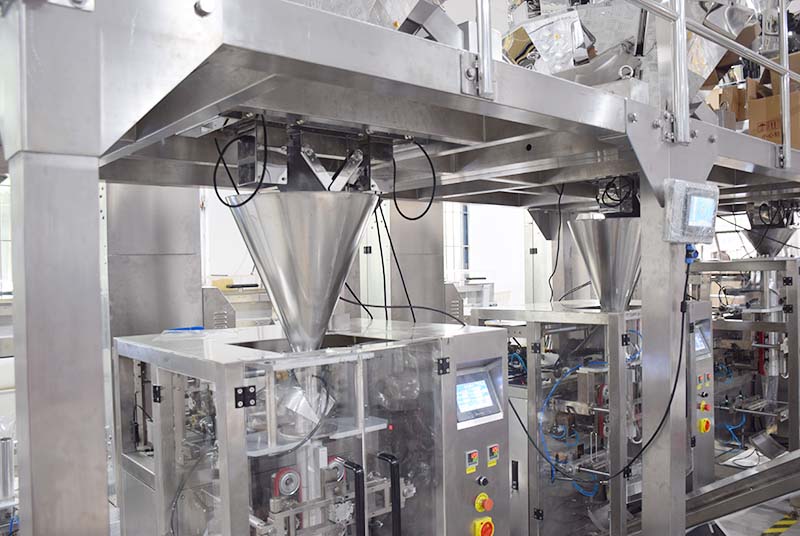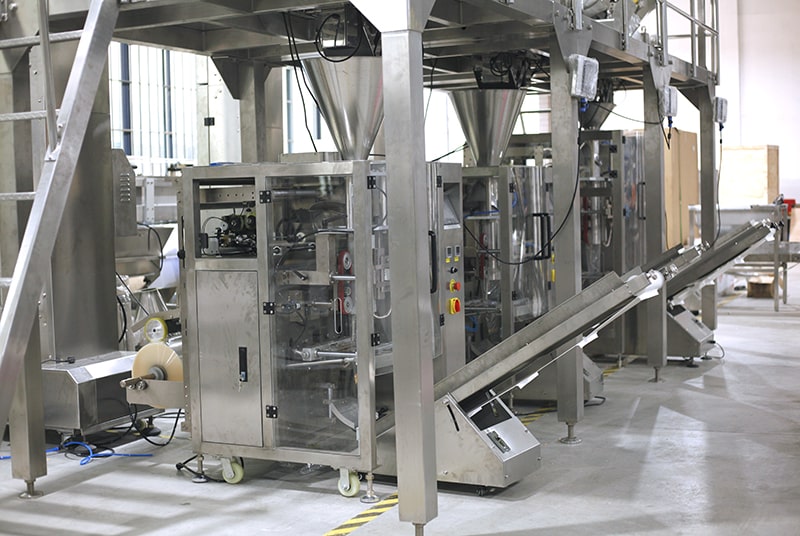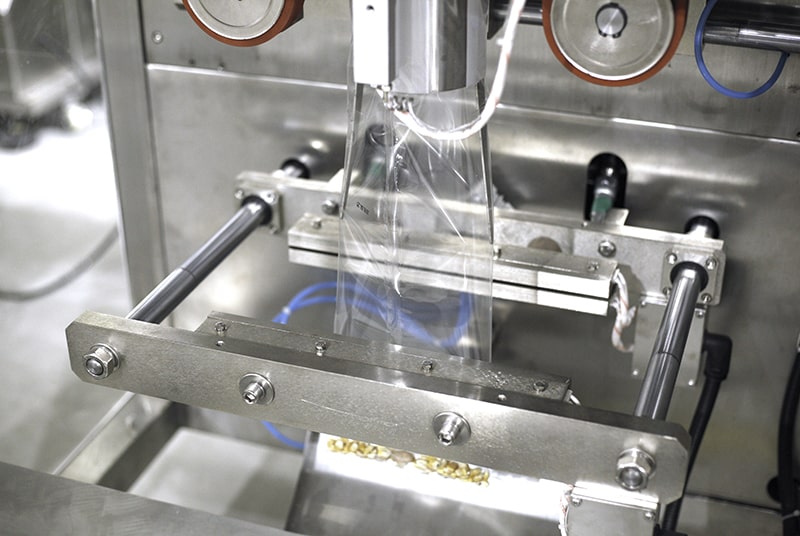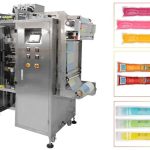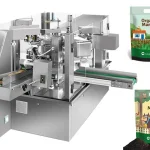Auto Chips, Popcorn, Snack, Crisps Puffed Food Packing System
Description
Application:
Suitable For Packing Puffed Food, Potato Chips, Popcorn, Candy, Biscuit, Sunflower Seed, Pistachio, Peanuts, Chocolate, Nuts, Pet Food, Small Metal Parts And Plastic Parts, Etc.
Kindly Reminder:
We have experienced team of R & D engineers who can customize packaging solutions according to your product characteristics.
Packing Exambers:

This packaging solution is suitable for large production packing.
Economical,save cost,small footprint.
Horizontal rewind conveying the material, with large transportion.
Feeding, Measuring, Bagging, Date printing, Charging(Exhausting) realising fully automation.
Imported PLC control system,colorful touch screen,easy operation, intuitionistic efficient.
Standard positioning with imported servo film transporting system and mark sensor.
With auto warning protection function to minimize loss.
High precision, high efficiency without crash the materials.
Parameter
| Model | VK-420A | VK-520A | VK-720A |
| Film Width | Max.420mm | Max.520mm | Max.720mm |
| Bag Length | 80-300mm | 80-350mm | 100-500mm |
| Bag Width | 60-200mm | 100-250mm | 180-350mm |
| Roll Diameter | Max.320mm | Max.320mm | Max.320mm |
| Film Thickness | 0.04-0.12mm | 0.04-0.12mm | 0.04-0.12mm |
| Packing Speed | 5-60bag/min | 5-60bag/min | 5-55bag/min |
| Power | 220V 50/60Hz 2KW | 220V 50/60Hz 3KW | 220V 50/60Hz 3KW |
| Machine Size | (L)1217*(W)1015*(H)1343mm | (L)1488*(W)1080*(H)1490mm | (L)1780*(W)1350*(H)2050mm |
| Machine Weight | About 650kg | About 680kg | About 750kg |
| Option Device | Two synchronous belt device, air filling device, angle fold device,automatic rectifying device, hole-punching device, link bag device. | ||
This article provides a comprehensive overview of automated puffed food packing systems for chips, popcorn, snacks and crisps. Automated puffed food packing systems are designed to quickly and efficiently package products such as chips, popcorn, snacks and crisps in a variety of sizes. These systems use advanced technology to ensure that the product is properly sealed and packaged with minimal waste. They also provide accurate weight control, ensuring that the product is packed correctly and consistently. This article will discuss the features of automated puffed food packing systems, their benefits, and how they can help improve productivity in your business.
Overview of Automated Puffed Food Packing Systems: An Introduction
Automated puffed food packing systems are a modern and efficient way to package a variety of snacks and other food items. These systems use advanced technology to quickly and accurately package items into pouches, bags, boxes, or other containers. The process is automated, allowing for greater speed and accuracy than manual packing methods. Automated puffed food packing systems are used in a variety of industries including snack food production, confectionery manufacturing, and pet food production. They offer many advantages over traditional packaging methods such as increased efficiency, improved product quality, reduced labor costs, and improved safety. Automated puffed food packing systems can also be customized to meet the specific needs of each individual customer. With the right system in place, businesses can enjoy faster turnaround times while still maintaining high standards of quality control.
Benefits of Automated Puffed Food Packing Systems for Chips, Popcorn, Snacks and Crisps
Automated puffed food packing systems are a great way to ensure the efficient and safe packaging of chips, popcorn, snacks and crisps. These systems are designed to automate the entire process from start to finish, from the initial filling of the product into the packaging material to the final sealing and labeling. This automation helps to reduce labor costs, improve product quality and consistency, and increase production speed. Additionally, automated puffed food packing systems provide a high level of accuracy when it comes to weight control and product protection. They also offer a variety of features such as automatic bagging, filling, sealing, labeling and more. These features help to ensure that all products are packaged correctly and securely while reducing the risk of contamination or damage during transit. Automated puffed food packing systems are an essential tool for any business looking to increase efficiency while maintaining quality standards.
Key Components of Automated Puffed Food Packing Systems
Automated puffed food packing systems are a type of packaging machinery designed to efficiently and accurately package puffed food products such as cereal, snacks, and other snacks. These systems typically consist of several key components that work together to ensure the safe and efficient packaging of the product.
The first component is a feeder system, which is responsible for feeding the product into the machine. This system can be manual or automated, depending on the needs of the manufacturer. The feeder system ensures that the product is fed into the machine in an orderly fashion, ensuring accuracy and consistency in packaging.
The second component is a weighing system, which is responsible for accurately measuring the weight of each package before it is sealed. This ensures that each package contains an accurate amount of product, preventing over- or under-packaging.
The third component is a sealing system, which seals each package securely to prevent contamination and ensure freshness. This system can use various methods such as heat sealing or ultrasonic welding to seal packages securely and quickly.
Finally, a labeling system is used to label each package with relevant information such as product name, expiration date, ingredients list, etc. This ensures that customers have all the necessary information about the product before purchasing it.
Overall, automated puffed food packing systems are designed to ensure accurate and efficient packaging of puffed food products. These systems use several key components such as feeders, weighing systems, sealing systems and labeling systems to ensure that products are packaged safely and correctly for customers’ convenience.
Considerations for Implementing Automated Puffed Food Packing Systems
Automated puffed food packing systems are a great way to streamline the production process and reduce costs. These systems offer several advantages, including increased efficiency, improved product quality, and reduced labor costs. However, there are several considerations that must be taken into account when implementing such a system.
First, the layout of the production line must be carefully planned in order to ensure that the automated system is properly integrated with existing equipment and processes. This includes considering factors such as the size of the production line, the types of machines needed for each step of the process, and any potential safety hazards. Additionally, it is important to consider how much space is available for installation and whether any modifications need to be made to existing equipment or processes.
Second, it is important to consider the type of automation technology that will be used in order to ensure that it is compatible with existing systems and meets all safety requirements. This includes evaluating different types of sensors and control systems as well as ensuring that they are properly integrated with existing equipment. Additionally, it is important to consider how much training will be required for operators in order to ensure that they can effectively use the automated system.
Finally, it is important to consider the cost associated with implementing an automated puffed food packing system. This includes evaluating different vendors in order to find one that offers competitive pricing as well as considering any potential maintenance costs associated with using such a system. Additionally, it is important to consider any potential long-term benefits associated with using an automated system such as increased efficiency or improved product quality.
Overall, there are several considerations that must be taken into account when implementing an automated puffed food packing system in order to ensure its successful integration into existing production lines and processes. By carefully evaluating these factors beforehand, companies can ensure that their investment in automation technology pays off in terms of increased efficiency and reduced costs over time.
Strategies for Ensuring Quality Control with Automated Puffed Food Packing Systems
Ensuring quality control with automated puffed food packing systems requires a comprehensive approach that includes the use of high-quality materials, precise engineering, and advanced technology. Quality control begins with the selection of reliable components such as servo motors, pneumatic cylinders, and sensors. These components must be designed to work together in order to ensure accurate operation. Quality assurance is also necessary to ensure that all components are properly installed and maintained.
To further ensure quality control, automated puffed food packing systems should incorporate advanced technologies such as vision systems and robotic arms. Vision systems can detect any flaws or defects in the product being packed while robotic arms can accurately place the product into its packaging. The system should also include safety features such as emergency stops and automatic shut-off mechanisms in case of malfunction or operator error.
Finally, quality control should also involve regular testing and maintenance of the system to ensure that it is functioning correctly. This includes testing for accuracy and speed as well as inspecting all components for wear or damage. Regular maintenance will help to extend the life of the system and reduce downtime due to malfunctions or errors.
Conclusion
In conclusion, automated puffed food packing systems for chips, popcorn, snacks and crisps are an invaluable asset for any business that produces these types of products. They offer a wide range of benefits such as increased efficiency, improved product quality, and cost savings. Automated puffed food packing systems can also help businesses reduce waste and improve their environmental impact. With the right system in place, businesses can maximize their profits while providing customers with the highest quality products.


